Because it is a thought-provoking city of contradictions …
Benares, first of all, has multiple names. It is an English version for the Indian counterpart Varanasi – which derives its name from the conjunction of two rivers Varun and Assi. Assi represents “the curve of a sword” that defines the direction river Ganges takes near the town. Kashi, another name, is remembered because it was one of the oldest (may be 5000 years back) civilizations, this side of Indus or Sindhu river.
Next time I go to Benares, I would read the following article and recommend all to read … by Professor PB Singh Rana
Beautifully done, the airport has placed major milestones in the history of Varanasi just outside the terminals. And the inside carries two important things, one a statue of the long forgotten Indian Prime Minister Lal Bahadur Shastri, and the other the photographs of the enthralling Aarti on the banks of the river Ganges. Aarti also spelled arti, arathi, aarthi is a Hindu religious ritual of worship, a part of puja, in which light from wicks soaked in ghee or camphor is offered to one or more deities.
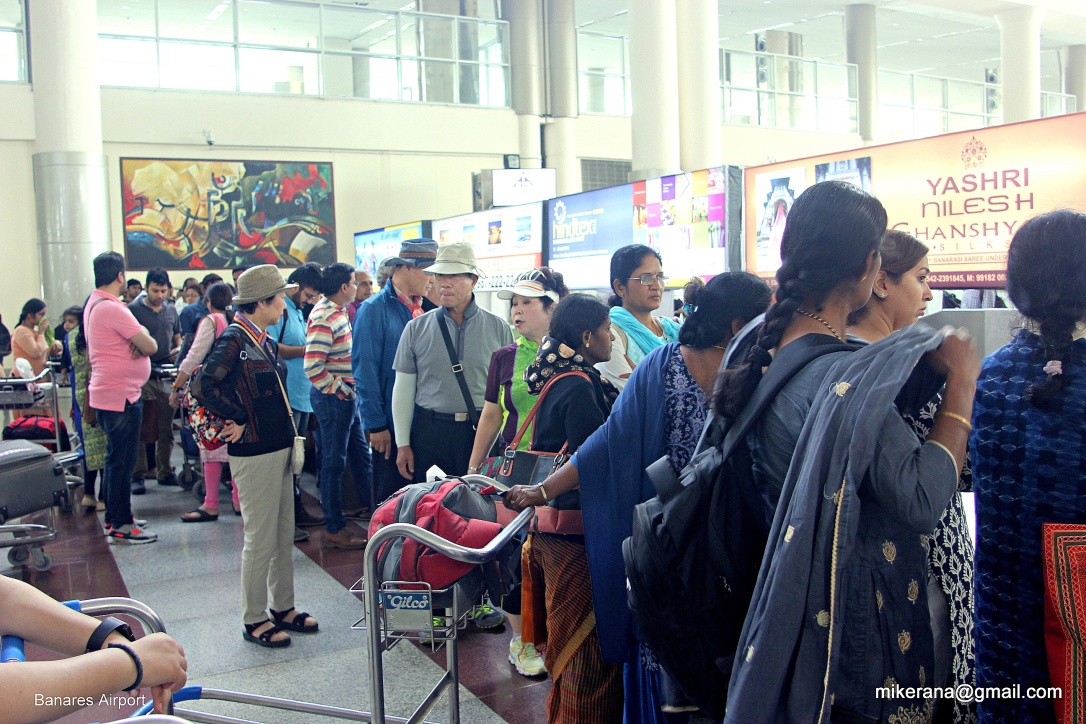




Photographs in and around the Benares airport
Whenever I undertake a travel in India my focus is to reach the best in traditions, culture and foods, unlike abroad where the cleanliness, rivers, gardens and greenery take the cake. I am a so called atheist. A religious place is not what attracts my attention unless something special is taking place there.
Music Concert at Sankat Mochan
Which presently was an Indian classical musical concert that takes place annually at Sankat Mochan Hanuman Temple. The festival, called the samaroh, is a collection of dance and music recitals performed by the leading artists of the country for a week, daily between seven PM to 6 AM. The artists perform here not simply as a recital or presentation to the audiences but as a devotional offering to the lord Hanuman, the ultimate in the minds of his followers as the master of music. In return, the audiences record their appreciation by raising their hands and uttering a slogan ‘Har Har Mahadev’, instead of clapping or giving standing ovation. Traditionally and religiously, the offering is called haazaari – meaning a formal presence in the court of the divine.
For the reporter, this annual festival brought together some of the Padma award winners. These awards are given to four or five most deserving people by the Government of India every year. We had a chance to see jubilant artists like Pt Jasraj, Pt Hari Prasad Chaurasia, Sonal Mansingh and Birju Maharaj under one roof, and that gives us enough reason to be there. We can’t forget or humble Zaved Akhtar the famous film dialogue writer, Malini Awasthi a versatile performer with a bewitching Hindi diction, Ronu Majumdar flutist, bhajan samrat (king of holy renderings) Pankaj Udhas and many others equally competent artists, who performed in the same way that is absolutely divinely. And I can’t say enough for the musicians who accompanied all of them.
Malini Awasthi
The changes in the schedule opened newer mysteries, almost on a daily basis as the festival progressed. After all, getting so many artists of international fame to perform within one week a year, must have been an immense challenge to the organisers.
And we all wondered how the night simply passes when we are engrossed in that kind of music. Here the singers or dancers were just two or three for a performance that could last for hours. Similar nightly conducted European and American concerts deploy a large number of musicians for each performance. But that comparison is not fair since each style is just the way the music is composed or sung in a country.
We didn’t feel the need of augmenting our presence by eats or drinks, though the street food was available within meters of the location. The overtures of music eclipsed the religious propositions of the city as they also took care of our moods. Television screens and loudspeakers installed all over the premises, including the trees, facilitate a close enough view of the performance. In spite of its immense popularity, no entry fee was charged to the visitors.




 Sankat Mochan Temple and surroundings
Sankat Mochan Temple and surroundings
Captivating music is not the only treat at Varanasi
While the nights took care of our moods and kept us engrossed, the sleepy mornings were generally packed with long trips to different locations. Every day, we hired a new vehicle and a new taxi driver so we could interact with different locals. I prefer to go with the flow of local stereotypes of people, place or things, since that facilitates a good input of traditions, culture and environment. I think every trip causes some change in my personality and that precisely is the point. I became more Indian than what I was before. Our experience builds up this way.
All cities are the same but each has a unique proposal, sometime the diversity of population, sometime an intriguing network of connecting roads, and sometime interesting parks and gardens. I don’t know why we look at people, culture and eating habits with a lens that is not as diverse as the realities are. Our own inadequacy, I think.
Cities are as what they are famed for. Delhites with their flare for show off, are certainly different from the down to earth Bombayites and the competitive Tamilians or art oriented Bengalis.
Varanasi, from an angle of religion, culture and history causes our lens to be biased a bit. People from Varanasi should not be called merely as religious, or of blind faith. They are modern with mobiles, televisions and shopping malls. But they are simple, treading on the lines their forefathers drew. And that includes Banarasi Thugs, who made their fortunes working on the simplicity of the locals as well as the unawareness of travellers. But it is sad that the city is still struggling to get parking lots defined and constructed.
I didn’t sit with a traditional diary on the Ghats of Ganges to record my observations, because that was too diverting for the people they were alive with. It was more productive to take snaps instead, and I now convert these to a descriptive travelogue.









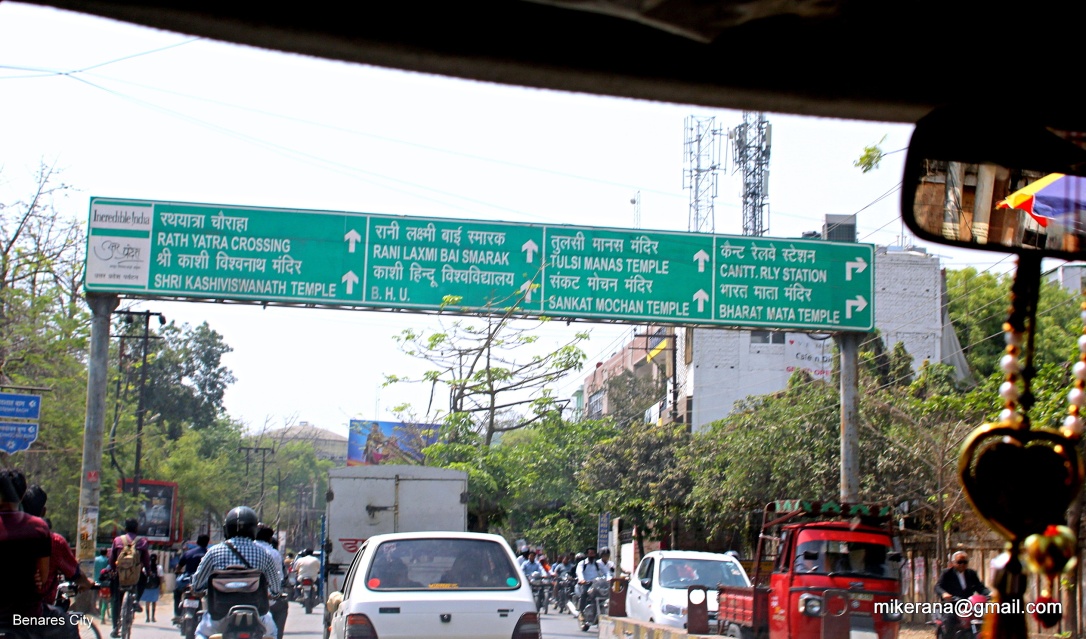
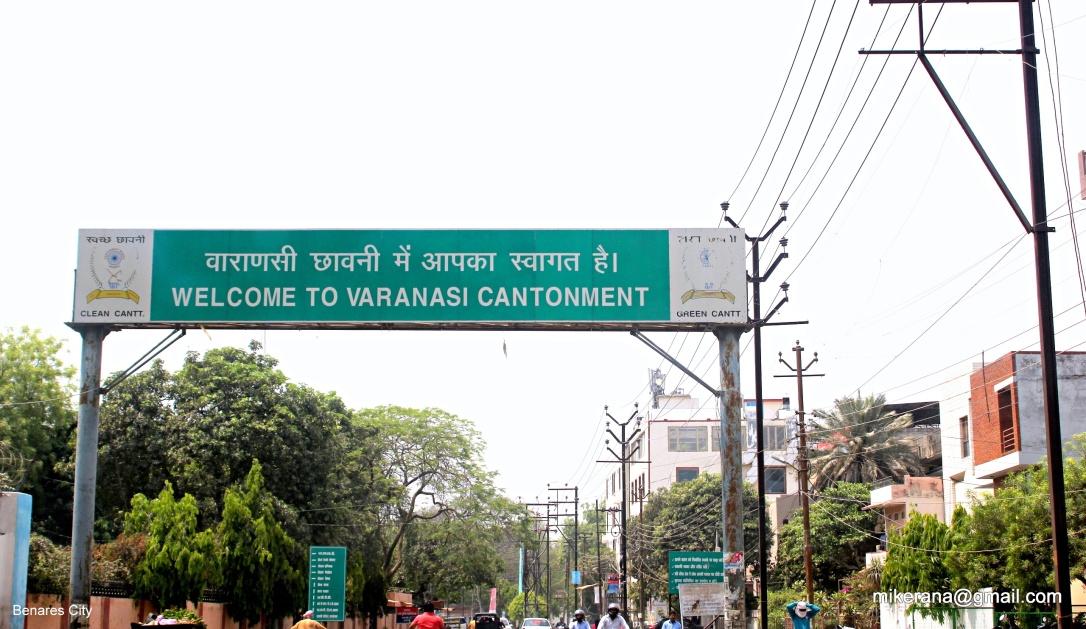

The city beautiful in spite of road repairs
Neatness and cleanliness
My first observation was Varanasi is not dirty, at least in the major areas I looked around. The taxi drivers told us it was said to be worse before India’s current Prime Minister Mr Narendra Modi, adopted this city as his own. The credit obviously goes to him. They thought they will vote for him in the next election.
He convinced and almost brainwashed people, both local and more aptly the travellers, to abandon polythene bags from the Waters of Ganges. He promoted bringing neatness around with his slogan of Swatchh Bharat (Clean India). But he couldn’t convince them to adopt a healthy living style. His messages on Yoga fell flat on deaf ears of the locals, unlike on receptive ears of the foreigners all around the world. The ill health of people, other than probably the wrestlers, is apparent from their pot bellies filled all the time with Pahalwan’s Lassi (a sweet drink made from curd) or with red Pedas (a popular sweet from milk) from innumerable sweet shops. Unlike many other places, the monkeys here are ill fed. But feeding is compensated by the beer bellies of people, openly and with no shame. For a traveller to avoid these attraction needs some strong will power.
People are all beautiful be it from anywhere in a country. But the Upites are known for religious vigour and their enhanced enticing personas and sensualities. They might be competing equally well with the chitpawans in Maharashtra, Ayers in Tamilnadu or the Mallu girls in Kerala. Their Hindi language is well beyond any limits imposed by the grammar.
That the people are taking good care of the heritage lamps is remarkable. These are a toned down version of lamps installed everywhere in Paris. Here they stretch over about 10 kilometres of the main road in the city. Wish they had finished the on-going repairs to the road before putting these expensive lamps. The underground laying of gas pipes, internet and electric wires is again a creditworthy effort.
Hope I will see a transformed city after two years. At least the major link between airport and the city would have been completed.
Heritage lamps on the streets
The religious beliefs
The city thrives on religious feelings of the people as well the travelers. Most temples flourish, though flourish may be a wrong word, because of the faith people have in them.
The Kal Bhairav temple is a popular shrine not merely because it is religious but because if you don’t visit it, your future visits in Varanasi could suffer, as was the case with Mr Modi. Storms and torrents prevented him to flag off new projects, in spite of so much expense the political parties made on preparations. Only when the PM visited the Kal Bhairav temple these projects could be initiated. This trait of this temple gives it the metaphor of the Kotwal (watchman) of Varanasi.
Very bulky Pipal (Ficus religiosa or sacred fig) and Bargad (Banyan) trees enclose the entire city, because both these are considered religious. They don’t cut their branches and these are worshipped too. Perhaps this is the only reason that greenery is maintained in Varanasi. However, the fact that there may be utter dampness in the subsoil because of the proximity of Ganges is also important. But whatever it is … it is a great treat to find greenery.

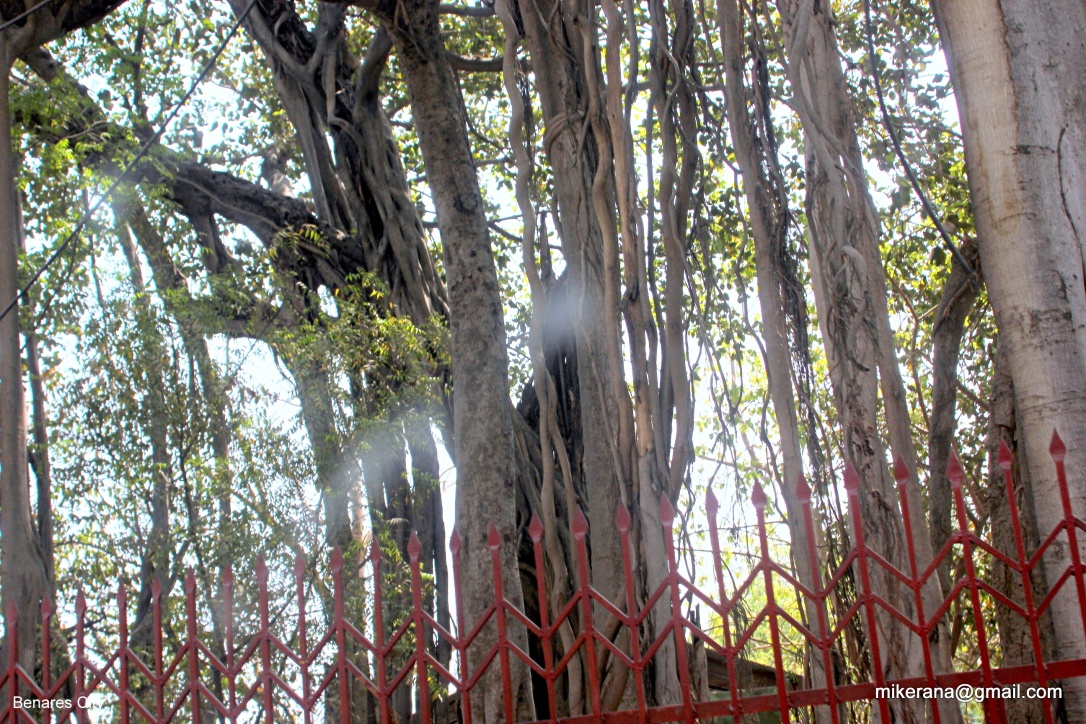
Pipal and Banyan trees
Our hotel owner, while describing the hotel architecture told us that there were three reasons why they put protective grills on the back of the rooms. To prevent suicides, to evade the monkeys and also to prevent thieves.
Shri Kashi Vishwanath Mandir – The Mangla Aarti
Some commercial photographs
An awe-inspiring temple of Lord Shiva exists in Varanasi. I didn’t visit it because I didn’t subscribe to the idea of standing in the queue that promote religious sales, like the Tirupati temple of the south. There are five types of Aarti processes designed with unique and quite expensive prices namely Mangala, Bhog, Sandhya, Shringar, Shayan, at different times of the day. The most important of these being Mangala Aarti conducted between 3.00-4.00 (morning) for which the entry queue commences from 2 am. Although I didn’t visit it but I recommend it for all devotees and visitors to Varanasi. This entrance to this religious Aarti is also available through the web-site owned by someone from the south.
Benarasi Paan
One cannot return from Varanasi without having a taste of the famous benarasi paan. Paan is a preparation combining betel leaf with areca nut and sometimes also with tobacco. To see all its varieties, the green leaf, the almost white leaf and the yellow leaf, I recommend it should be taken at least once daily, from different vendors. The best that our taxi driver arranged was from the shop shown below. It is not a paan served in hand but in a well decorated plate. The vendor told me the difference between Banarasi paan and Maghai paan, which primarily differ in the colours and the warmth that each one gives on you ears.
A picture of a famous paan shop
Benares Hindu University
A religious city with hundreds of malls, a musical city with hundreds of temples supporting music also has the biggest and oldest literature circle of the country here. It carries with itself the older name as Kashi Vidyapeeth as well as the Benares Hindu University.
We can’t forget a state that gave us so many prophets, saints, sages, gurus, pandits, manuscript writers, poets, playwrights and above all a printing press ‘Geeta Press’ for distribution of spiritual and religious books promoted very near this city. Learned professionals are making their mark through the prestigious Indian Institute of Technology that is housed within the BHU campus. A question that a large chunk of population of foreigners still come to get educated in the university and get absorbed therein.


BHU Photographs with Sayaji Central Library and an Indian Institute of Technology.
But we can’t remain oblivious to the politics based on religions going on in this university. Off late a police lathi charge was carried out on young girl students, that still is a burning issue.
Those Glorious Ghats of river Ganges
I can’t write enough on the traditions and popularity of ghats of the river Ganges. Instead some photographs may do justice. For more details, one must read the Google texts.
More Ganga ghats photographs
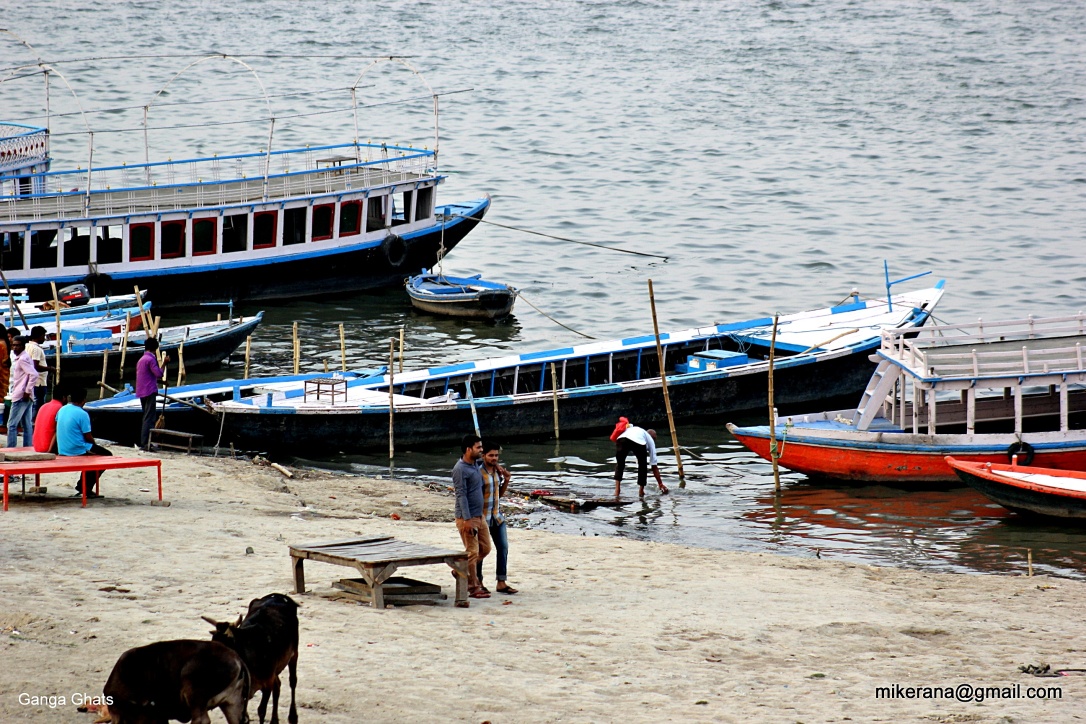



The Manikarnika or Moksha Ghat
One particular ghat that deserves special mention. According to Indian mythology a human life cycle goes through a few stages known as Ashrams, namely Brahmacharya (student), Grihastha (householder), Vanaprastha (retired) and Sannyasa (renunciation). To indicate the commencement of each of these ashrams, the river Ganges provides different official ceremonial places in its ghats.
The Manikarnika ghat is the only ghat in India where unendingly pyres are burnt 24 hours a day, irrespective that the Indian tradition of burning a dead body is only during the day time ie when the Sun is visible in the sky. If a dead body finds its ultimate abode in this Ghat, for which of course one has to wait many hours, it is believed that the soul will achieve salvation. You can choose to be burnt here, in other words you can be dying here.


Death is also a place for tourism here. The city is mysterious but it is evident that it has its reason. The criticism and condemnation of these place is now being rectified.
Sarnath 10 Kilometres away
Buddha came to Sarnath to preach his message of the middle way to nirvana after he achieved enlightenment at Bodhgaya, and gave his famous first sermon to his first five disciples here in the deer park in Sarnath. This event is referred to as “the turning of the wheel of the Dharma” and also marks the founding of the Sangha, or the community of monks.
Sarnath is one of four holy Buddhist sites sanctioned by the Buddha himself for pilgrimage located north-east of Varanasi near the confluence of the Ganges and the Varuna rivers. The other three sites being Lumbini (birth) Bodh Gaya (enlightenment); and Kushinagar (death).

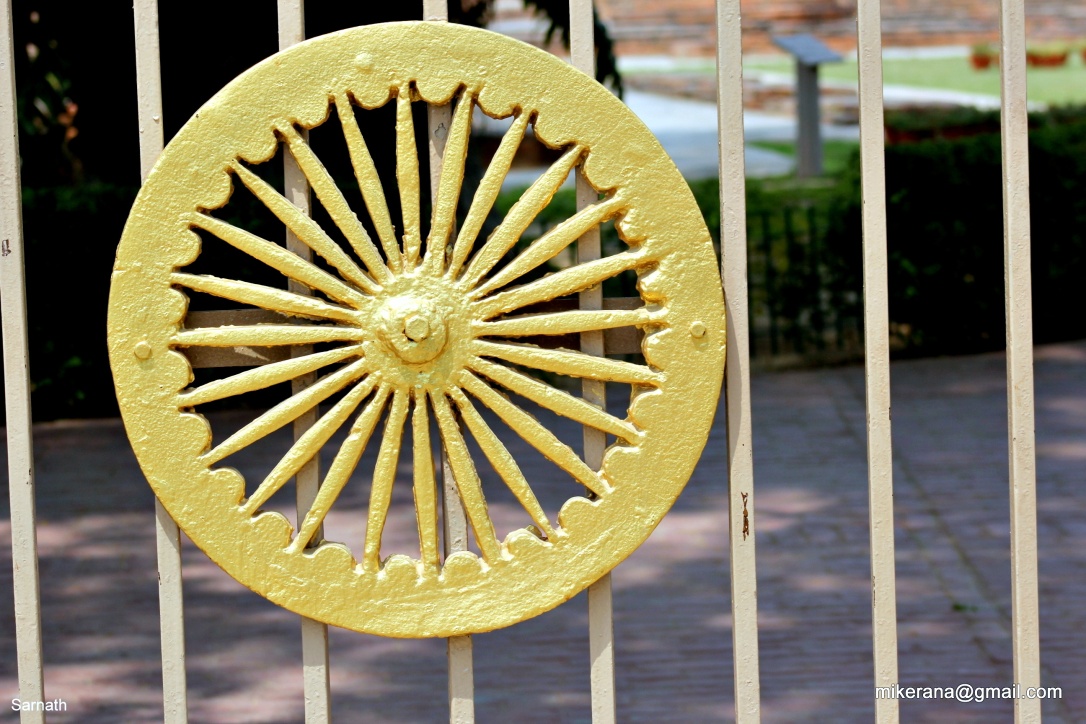







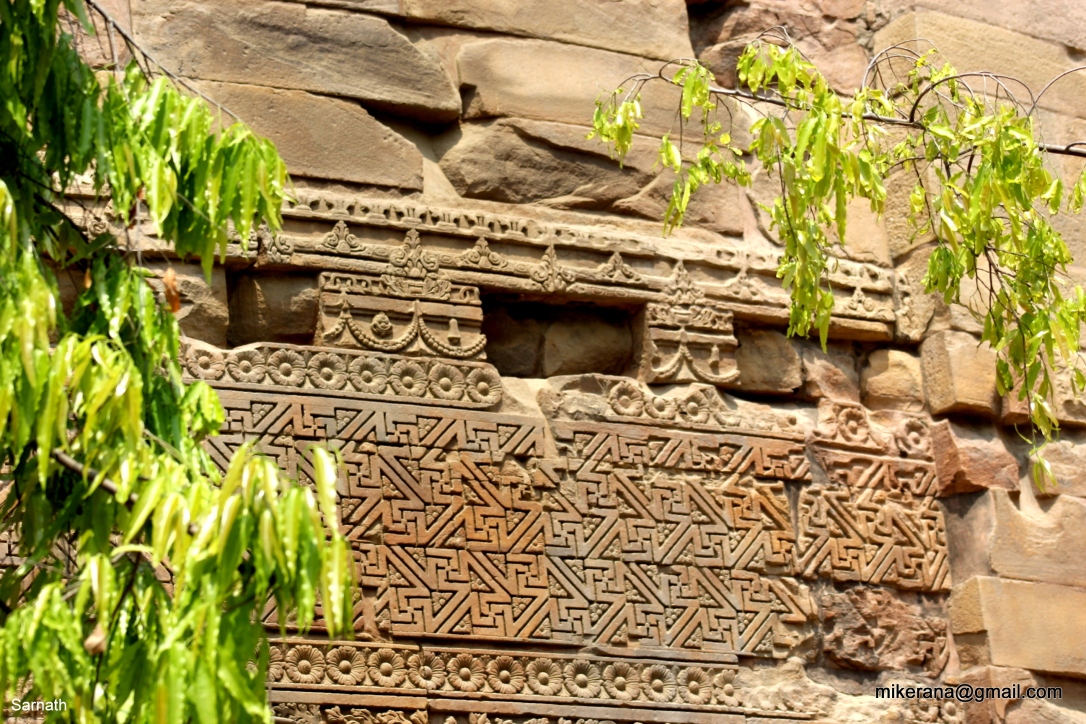
In the 3rd century BC, Emperor Asoka had magnificent stupas and monasteries erected here, as well as an engraved pillar.
There must be something good and worth imbibing in Buddhism that this place looks so neat and tidy, or is it because the central government (the heritage ministry) takes care of it and not the local state government.
Closing Remarks
Where Pahalwan’s Lassi, street foods and banarasi paan survive over the beers or hamburgers, where hundreds of temples flourish, where internet has taken over the Mangala Aarti, and goons have stopped terrorizing the 4 wheel owners, there must be something unique here.
Where the empty spaces (in unitized acres) or dilapidated buildings owned by people who can’t think of utilising them, still exist in close proximities to the are still unseen by the real estate promoters, life still goes on, and satisfactorily.
Where roads are meant to be dug and facilities like gas-pipes or internet or even power are underneath instead of the traditionally on surface, something unique must be happening here.
Where hundreds of malls flourish in spite of no place for parking and where people still manage to come over to the malls, and give them the necessary footfalls, it must be unique to this city.
Last when an article on a religious city written by an atheist must be something to reckon with. But there must have been some driving force behind this travelogue. Don’t read too many I’s in the article it is because this is a true eye version of a traveller.






























































Very lucid and well written , Benares or Varanasi is more beautiful after one reads this article.
LikeLiked by 1 person
I love that you appreciate this article. But believe me I kind of fell in love
LikeLiked by 1 person
After reading this article I feel like visiting Benaras…. very well written.
LikeLiked by 1 person
I knew all spiritual, cultural people will like what I said about Varanasi. Next year same time look out for Sankat mochan samaroh
LikeLiked by 1 person
Beautiful read of Benares – a city that has indeed a magnetic pull on our pshche I was always drawn towards it so visited last year most of the places n temples talked about by you ! Other two places – Gaya n Bodh Gaya specially add to the mystical experience of Benares ! One thing dear mike you missed are the world famous Benares sarees , since ages they hold the same charm n popularity so we did spend time in the bazaars loaded with these n emptied our pockets !!! Thumbs up dear for a bringing out the beauty of this awesome city in ur penpicture 👍👍👍👍💐💐
LikeLiked by 2 people
As usual Madhusuri you are very involved in spite of your busy schedule with Udaan, and tat should be appreciated. Yes, no doubt I missed the sarees of Benares but next time I will certainly write something about the hand-loom industry and the people who spend their lives in it without due appreciation by the marketeers and the government.
But let me add, there was an aspect of geo-cosmic alignment of this city that I missed. The city drives its power from the magnetic and spiritual energies that it contains. You can transfer you soul to any part of the universe from this city.
May be the moksh ghat on the Ganges is because of this phenomenon.
LikeLiked by 2 people
Thank you .. see my reply
Sent from Mail for Windows 10
LikeLike
Great summary on Kashi a place which cannot be compared You made me to recollect my visit which was before my joining AF My solid impression about BHU is not seen from your write up Airport and Sankatmochan musical organisation is news It must be like Pune savaigandharv concerts good to know did you visit Birla mandir inside BHU? You would have loved it
Last I visited Benares was twenty years back to immerse my fathers ashes in south we consider it as a requirement for salvation
Love to read your blogs I liked it sir my good wishes to you and your family
LikeLiked by 2 people
Thank you GSN, as usual you always encourage me. The thing about the mokhsghat is described in my article towards the end. This is a place from where one can descend into any place into the universe and beyond into salvation.
In the beginning of the article there is a link about Geo-cosmogram that tells us in details what a city like Benares is based upon. All the figures and diagrams given therein are sufficient to attract your interest in salvation and souls travels . The city has an awesome and unparalleled geometrical and spiritual foundations.
I suggest you read it again, it was added recently (in different colour) to the article.
LikeLiked by 2 people
Thanks for this comprehensive travelogue, Sir.
With kind regards,
Stuti
LikeLiked by 2 people
S Stuti, It’s always pleasing to get comments from someone, who cares for the content. and if these are good the more pleasant it becomes
LikeLiked by 2 people